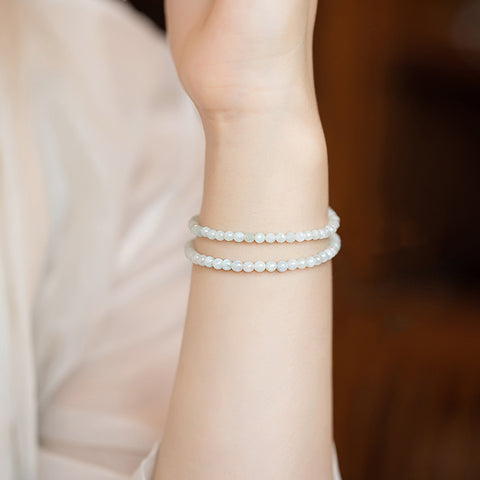2Jewellery New chic Beaded Bracelets For Women
2Jewellery New chic Beaded Bracelets For Women, Jadeite women's bracelet。 jadeite, also known as jadeite, Burmese jade, is a kind of jade, Burmese Jade remains one of the highest quality variations of this gemstone known for its firmer, denser, and more lustrous shine. The Burmese Jade was the most important and sought-after historically in China and today it continues to be one of the most sought-after varieties. As per standard color nomenclature, jadeite’s colors are best described by breaking them down into three color components: hue, saturation, and tone. The color distribution must also be taken into account.
Hue: Top-quality New chic jadeite women's bracelet is pure green. While its hue position is usually slightly more yellow than that of a fine emerald and it never quite reaches the same intensity of color, the ideal for jadeite is a fine “emerald” green. No brown or gray modifiers should be present in the finished piece.
Saturation: This is by far the most important element of green and lavender jadeite color. The finest colors appear intense from a distance (sometimes described as “penetrating”). Side-by-side comparisons are essential to judge saturation accurately. Generally, the more saturated the hue is, the more valuable the stone will be.
Tone: The ideal jadeite women's bracelet tone is medium – not too light or too dark.

2Jewellery women's bracelet Distribution: Ideally, color should be completely even to the unaided eye, without spotting or veins. In lower qualities, fine root- or vein-like structures that contrast with the body color of the stone may be considered attractive. However, dull veins or roots are less desirable. Any form of mottling, dark irregular specks, or blotches that detract from the overall appearance of the stone will reduce the value.
Clarity: This refers to imperfections that impair the passage of light. The finest jadeite has no inclusions or other clarity defects that are visible to the naked eye.
Typical imperfections are mineral inclusions, which usually are black, dark green, or brown, but maybe other colors. White spots also are common, as are other intergrown minerals. The most severe clarity defects in jadeite are fractures (healed or unhealed), which can have an enormous impact on value because jadeite symbolizes durability and perfection。
Translucency (diaphaneity): This is another important factor in evaluating quality. The best jadeite is semi-transparent; opaque jadeite or material with cloudy patches typically has the least value.
It is interesting to note that even if the overall color is uneven or low in saturation, jadeite can still be quite valuable if it has good transparency.

Texture: In jadeite, the texture is intimately related to transparency. In the authors’ experience, typically the finer the texture is, the higher the transparency will be. Further, the evenness of the transparency depends on the consistency of the grain size. Our observations also suggest that coarse-grained jadeite tends to have more irregularities, blotches, or discolorations.
The texture is key to the classification of fashioned jadeite into three categories: fine (Lao keng, or “old mine”), medium (jiu keng, or “relatively old mine”), and coarse (in keng, or “new mine”), Note that Chinese jadeite dealers also use the terms “old mine” (keng Zhong) and “new mine” (in shan zi) to describe rough. This is not really an expression of the age or location where the jadeite is mined, but more an indication of texture and translucency, with old-mine jadeite having a higher quality, being of finer grain size, and having greater luster and translucency. It probably derives from the belief that jade that is more compact and of finer texture is of greater age.
Polish is particularly important with jadeite. Fine polish results in fine luster, so that light can pass cleanly in and out of a translucent or semi-transparent piece. One method of judging the quality of the polish is to examine the reflection of a beam of light on the surface of a piece of jadeite. A stone with fine polish will produce a sharp, undistorted reflection, with no “orange-peel” or dimpling visible.
Jade (primarily nephrite) has been prized in China for thousands of years. Yet the finest jade – jadeite – has been a part of the Chinese culture only since the late 18th century, when the mines in what is today north-central Burma were opened. As the first Western gemologists to enter the remote jadeite mining area in more than three decades, the authors witnessed tens of thousands of miners working the rivers, Uru conglomerate, and in-situ deposits in search of jadeite. Backhoes, trucks, pneumatic drills, and rudimentary tools are all enlisted in the different mining operations.
2Jewellery beaded bracelets for women Fashioning: More so than for most gem materials, fashioning plays a critical role in jadeite beauty and value. Typically, the finest qualities are cut for use in jewelry – as cabochons, bracelets, or beads. Cutters often specialize: one may do rings, another carving, and so on.
Beads:Strands of uniform jadeite beads are in greater demand than those with graduated beads. The precision with which the beads are matched for color and texture is particularly important, with greater uniformity resulting in greater value . Other factors include the roundness of the beads and the symmetry of the drill holes. Because of the difficulties involved in matching color, longer strands and larger beads will carry significantly higher values. Beads should be closely examined for cracks. Those cracked beads of 15 mm diameter or greater may be recut into cabochons, which usually carry a higher value than a flawed bead.
2Jewellery beaded bracelets for women:Bangles are one of the most popular forms of jadeite jewelry, symbolizing unity and eternity. Even today, it is widely believed in the Orient that a bangle will protect its wearer from disaster by absorbing negative influences. For example, if the wearer is caught in an accident, the bangle will break so that its owner will remain unharmed. Another common belief is that a spot of fine color in a bangle may spread across the entire stone, depending on the fuqi – good fortune – of the owner. In the past, bangles (and rings) were often made in pairs, in the belief that good things always come in twos 。
Believed to date back at least four millennia in China, the jade bangle is both one of the oldest and one of the most important pieces of jewelry in the Chinese culture.
As noted above, much jadeite is discolored by rust-like oxidation stains. jadeite that has been soaked in chemical bleaches and/or acids for an extended period to remove brown or yellow impurities from between grain boundaries and cracks. Because this treatment process leaves voids in the jadeite, the bleached jadeite is subsequently impregnated with paraffin wax or, most commonly, a clear polymer resin. The result is usually a significant improvement in both transparency and color. However, detection of this enhancement generally requires infrared spectroscopy, a sophisticated technique that usually must be performed in a gemological laboratory.
2Jewellery New chic women's bracelet Jadeite Buying Guide:
- Introduction:The term jade is used for two different minerals, jadeite and nephrite. Only jadeite has value as a gem material in and of itself.
- Color: For jadeite, the intensity of the green color, combined with a high degree of translucency are the key factors in judging value. Stones which are too dark in color or not so translucent are less highly valued. Ideally, color should be completely even to the unaided eye, without spotting or veins. In lower qualities, fine root- or vein-like structures that contrast with the body color of the stone may be considered attractive. However, dull veins or roots are less desirable. Any form of mottling, dark irregular specks, or blotches that detract from the overall appearance of the stone will reduce the value.
- Translucency:This is another important factor in evaluating quality. The best jadeite is semi-transparent; opaque jadeite or material with cloudy patches typically has the least value. It is interesting to note that even if the overall color is uneven or low in saturation, jadeite can still be quite valuable if it has good transparency.
- Texture:In jadeite, texture is intimately related to transparency. Typically, the finer the texture, the higher the transparency. Further, the evenness of the transparency depends on the consistency of the grain size.
- Clarity:In terms of clarity, fine jadeite should be free from noticeable or distracting inclusion defects. This refers to imperfections that impair the passage of light. The finest jadeite has no inclusions or other clarity defects that are visible to the naked eye. Typical imperfections are mineral inclusions, which usually are black, dark green, or brown, but may be other colors. Black spots easily visible to the eye are a particular problem because the Chinese associate them with bad luck. White spots also are common, as are other intergrown minerals. The most severe clarity defects in jadeite are fractures (healed or unhealed), which can have an enormous impact on value because jadeite symbolizes durability and perfection. That said, virtually all jadeite has feathers that are visible under magnification.
- Cut:Fine jadeites are usually cut as cabochons. Material used for cabochons is generally of higher quality than that used for carvings, although there are exceptions.
With cabochons, the key factors in evaluating cut are the contour of the dome, the symmetry and proportions of the cabochon, and its thickness. Cabochon domes should be smoothly curved, not too high or too flat, and should have no irregular flat spots. Proportions should be well balanced, not too narrow or wide, with a pleasing length-to-width ratio.
- Prices:Next to certain rare colors of diamond (such as blue, pink and red), jadeite is the world’s most expensive gem, with prices above even ruby and sapphire.
Nephrite has little value as a gem in and of itself, but carvings can be quite valuable.
- Stone Sizes:While jadeite sometimes occurs in pieces of several tons or more, top cut jadeite of even five carats is large and quite valuable.

2Jewellery women's bracelet Jadeite jewelry: Traditionally, when fine jadeite cabochons are mounted in jewelry, they are backed by metal. The metal acts as a foilback of sorts, increasing light return from the stone. Often, a silver-colored plating is added to the inside of this backing to further increase reflection. The metal generally contains a small hole in the center, so one can shine a penlight through the stone to examine the interior, or probe the back with a toothpick to determine the contours of the cabochon base.
- Sources:The most important source of gem quality jadeite is Upper Burma, near the small town of Hpakan. Today, virtually all top-quality jadeite is produced from these mines. Other jadeite localities include Guatemala, Russia, Kazakhstan, Japan and California, but all pale in comparison with Burma. No gem-quality jadeite is found in China. Ancient Chinese jade is nephrite, and was mined in far western China near Khotan. Nephrite is also produced in Taiwan, British Colombia, Alaska, Wyoming, Australia, Russia and New Zealand.
- Enhancements: Today, the vast majority of jadeite is dipped in wax as a final finishing step. This is considered a normal trade practice. All other enhancements are considered abnormal and adversely affect value. Some jadeite is dyed green or other colors and these dyed colors may fade with time. Other jade is bleached and then impregnated with a polymer. As with all precious stones, it is a good practice to have any major purchases tested by a reputable gem lab, such as the GIA or AGTA, to determine if a gem is enhanced.
- Lore:Among the various gems, no single stone has a closer relationship with a culture than jade with the Chinese. It is considered the “Stone of Heaven” and is thought to provide a bridge between this world and the next. Jade also played an important part in Mayan and Maori cultures. In each of the above cultures, jade was considered “beyond price.”



Leave a comment